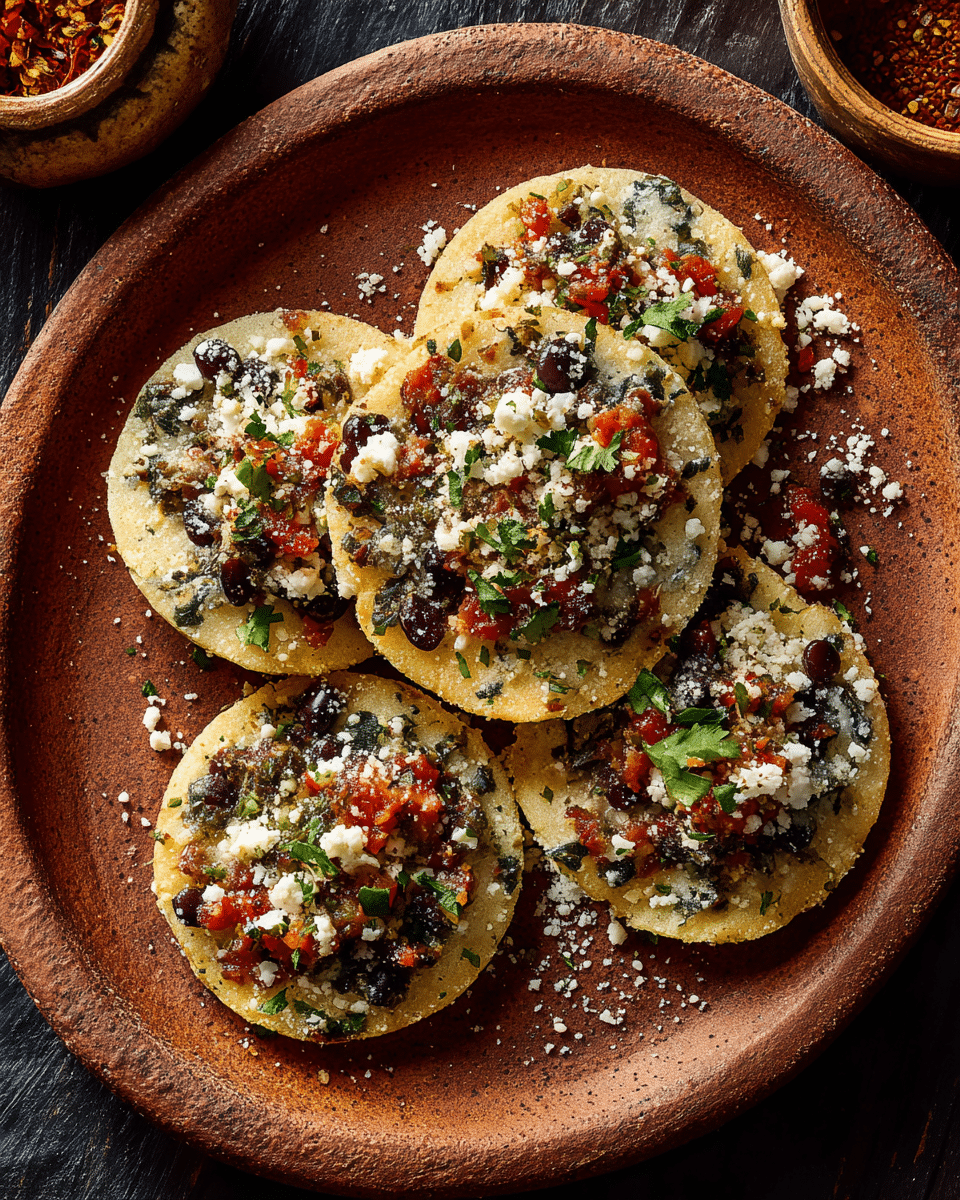Tlacoyos are a beloved Mexican street food, traditionally made from masa (corn dough) and stuffed with hearty fillings like beans, cheese, or fava beans. These oval-shaped cakes are pan-cooked or griddled until slightly crispy outside and tender inside. Popular in markets and during festive occasions such as Mexican Independence Day, they are often topped with nopales (cactus), salsa, cheese, and other vibrant garnishes.
FULL RECIPE
Ingredients
- 2 cups masa harina
- 1 ½ cups warm water (plus more if needed)
- ½ teaspoon salt
- 1 cup cooked and mashed black beans (or refried beans)
- ½ cup crumbled queso fresco
- ½ cup cooked nopales, sliced
- ½ cup salsa verde or roja
- ¼ cup chopped white onion
- 2 tablespoons fresh cilantro, chopped
- 1 tablespoon vegetable oil (for cooking)
Directions
- In a large mixing bowl, combine masa harina, salt, and warm water. Mix until a soft, pliable dough forms, adding more water if needed.
- Divide the dough into 8 equal portions and roll each into a ball.
- Flatten one ball into a thick oval disc using your hands.
- Place about 1–2 tablespoons of mashed beans in the center, then fold the masa over the filling, sealing edges carefully. Shape into an oval about ½-inch thick.
- Repeat with the remaining dough and filling.
- Heat a skillet or comal over medium heat and brush lightly with vegetable oil.
- Cook each tlacoyo for 3–4 minutes per side, or until golden spots appear and the masa is cooked through.
- Serve warm, topped with nopales, salsa, onions, cilantro, and queso fresco.
Nutrition Facts
- Calories: 165
- Protein: 6g
- Fat: 5g
- Saturated Fat: 2g
- Carbohydrates: 26g
- Fiber: 4g
- Sugars: 2g
- Sodium: 160mg
- Cholesterol: 7mg
Historical Significance of Tlacoyos
Tlacoyos have deep roots in Mexico’s pre-Hispanic history, with origins tracing back to the Aztec civilization. They were traditionally made using nixtamalized corn, a technique that enhanced nutrition and flavor. These oval-shaped stuffed masa cakes were a staple food, often eaten during market days or as part of communal celebrations. Today, tlacoyos remain a beloved street food, connecting modern Mexican cuisine to its ancient culinary traditions. Their continued popularity is a testament to their cultural and historical value, especially during festive occasions such as Mexican Independence Day.
Nutritional Profile and Health Benefits
Tlacoyos are nutrient-rich thanks to their primary ingredient, masa, which is high in fiber, complex carbohydrates, and essential minerals like magnesium. The nixtamalization process boosts calcium content and improves digestibility. When filled with beans or fava beans, they offer plant-based protein and additional fiber, which promote satiety and digestive health. Using fresh vegetables and moderate amounts of oil keeps the dish relatively low in fat. For those following vegetarian or gluten-free diets, tlacoyos can be a wholesome and satisfying choice.
Common Fillings and Flavor Variations
While the most traditional tlacoyo fillings are mashed beans, fava beans, and requesón (a type of fresh cheese), modern versions embrace a variety of flavors. Some cooks fill them with spicy chorizo and cheese for a richer profile, while others opt for sautéed vegetables for a lighter option. Seasonal ingredients, such as mushrooms or squash blossoms, also make delicious and unique fillings. This versatility ensures that tlacoyos can be adapted to different palates, dietary needs, and occasions without losing their authentic charm.
Cooking Methods and Texture Differences
Traditional tlacoyos are cooked on a clay comal, which imparts a subtle smoky flavor and slightly crisp texture. However, home cooks often use cast-iron skillets or non-stick pans with excellent results. Cooking without excessive oil allows the masa to develop a light crust while maintaining a soft, tender interior. Some regions boil or steam the filled masa cakes before searing, creating a softer bite. Adjusting cooking time and method can significantly influence the final texture, making this a dish that welcomes experimentation.
Traditional Garnishes and Toppings
One of the most delightful aspects of tlacoyos is the colorful and flavorful toppings that enhance each bite. Common garnishes include nopales (cactus strips), chopped onions, crumbled queso fresco, and fresh cilantro. Salsas—whether red, green, or smoky chipotle—add brightness and heat. Some street vendors also top them with shredded lettuce, radishes, or crema, creating a satisfying balance of temperature, texture, and flavor. These garnishes not only elevate taste but also showcase Mexico’s vibrant culinary aesthetics.
Serving Suggestions for Special Occasions
While tlacoyos make for a hearty everyday meal, they are particularly well-suited for festive gatherings. For Mexican Independence Day, serving them with red salsa, white cheese, and green nopales creates a dish that visually mirrors the national flag. Tlacoyos can be served as an appetizer platter for parties, allowing guests to try different fillings and toppings. Pairing them with aguas frescas, like hibiscus or tamarind, makes for a complete and refreshing celebration spread.
Pairings with Drinks and Sides
Tlacoyos pair beautifully with a variety of beverages and accompaniments. A warm atole or champurrado is a comforting option for breakfast or cooler days. For lunch or dinner, they go well with light soups, grilled vegetables, or fresh salads. On festive evenings, pairing them with Mexican craft beer or mezcal enhances their earthy flavors. The balance between the hearty masa cakes and refreshing sides ensures a satisfying dining experience without overwhelming the palate.
Regional Differences in Tlacoyos
Different regions of Mexico have their own distinctive approach to making tlacoyos. In central Mexico, they are often topped generously with nopales and cheese, while in Puebla, you might find versions with local herbs and more spice-forward fillings. In some indigenous communities, the dough is tinted with natural colorants like blue corn, giving the dish a striking appearance. These regional nuances not only diversify the eating experience but also highlight Mexico’s rich culinary diversity.
Tips for Storing and Reheating
Tlacoyos are best enjoyed fresh, but they can be stored and reheated for later enjoyment. Once cooked, they should be cooled completely before being placed in an airtight container in the refrigerator, where they will last for up to three days. To reheat, place them on a hot skillet or comal to restore their outer crispness, or warm them in the oven wrapped in foil. Avoid microwaving, as it can make the masa rubbery and compromise texture.
Making Tlacoyos Healthier
For a lighter version of tlacoyos, consider using whole-grain or blue corn masa, which provides additional antioxidants and a nuttier flavor. Reducing oil in the cooking process and loading up on vegetable toppings can also improve the nutritional profile. Filling them with lentils, quinoa, or lean meats offers more protein without excessive fat. With thoughtful ingredient choices, tlacoyos can be transformed into a nutrient-dense meal that still retains its comforting and traditional character.
Conclusion
Tlacoyos are much more than a delicious stuffed masa cake they are a living link to Mexico’s culinary history, a canvas for creative fillings, and a versatile dish fit for both everyday meals and grand celebrations. Whether topped with fresh vegetables for a light lunch or dressed in patriotic colors for Independence Day, they embody the warmth and vibrancy of Mexican cuisine.






